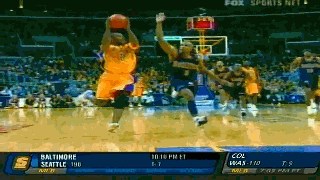POJ 2253 Dijkstra
Frogger
Time Limit: 1000MS Memory Limit: 65536K
Total Submissions: 27128 Accepted: 8824
Description
Freddy Frog is sitting on a stone in the middle of a lake. Suddenly he notices Fiona Frog who is sitting on another stone. He plans to visit her, but since the water is dirty and full of tourists' sunscreen, he wants to avoid swimming and instead reach her
by jumping.
Unfortunately Fiona's stone is out of his jump range. Therefore Freddy considers to use other stones as intermediate stops and reach her by a sequence of several small jumps.
To execute a given sequence of jumps, a frog's jump range obviously must be at least as long as the longest jump occuring in the sequence.
The frog distance (humans also call it minimax distance) between two stones therefore is defined as the minimum necessary jump range over all possible paths between the two stones.
You are given the coordinates of Freddy's stone, Fiona's stone and all other stones in the lake. Your job is to compute the frog distance between Freddy's and Fiona's stone.
Input
The input will contain one or more test cases. The first line of each test case will contain the number of stones n (2<=n<=200). The next n lines each contain two integers xi,yi (0 <= xi,yi <= 1000) representing the coordinates of stone #i. Stone #1 is Freddy's
stone, stone #2 is Fiona's stone, the other n-2 stones are unoccupied. There's a blank line following each test case. Input is terminated by a value of zero (0) for n.
Output
For each test case, print a line saying "Scenario #x" and a line saying "Frog Distance = y" where x is replaced by the test case number (they are numbered from 1) and y is replaced by the appropriate real number, printed to three decimals. Put a blank line
after each test case, even after the last one.
Sample Input
2
0 0
3 4
3
17 4
19 4
18 5
0
Sample Output
Scenario #1
Frog Distance = 5.000
Scenario #2
Frog Distance = 1.414
Source
Ulm Local 1997
Source Code
Problem: 2253 User: Grant Yuan
Memory: 516K Time: 16MS
Language: C++ Result: Accepted
Source Code
//Grant Yuan
//Dijkstra
#include<iostream>
#include<cstdio>
#include<cstring>
#include<cmath>
using namespace std;
const int inf=0x3ffffff;
int n;
struct node
{
double x,y;
};
node e[207];
double ans[207][207];
double dis1(node n1,node n2)
{
return sqrt((n1.x-n2.x)*(n1.x-n2.x)+(n1.y-n2.y)*(n1.y-n2.y));
}
bool uesd[207];
double dis[207];
void dijkstra()
{
for(int i=0;i<n;i++)
{
uesd[i]=0;
dis[i]=inf;
}
dis[0]=0;
while(1){
int v=-1;
for(int i=0;i<n;i++)
{
if(!uesd[i]&&(v==-1||dis[i]<dis[v])){
v=i;
}
}
if(v==1) break;
if(v==-1) break;
uesd[v]=1;
for(int i=0;i<n;i++)
{
if(!uesd[i]&&dis[i]>max(dis[v],ans[v][i]))
dis[i]=max(dis[v],ans[v][i]);
}
}
}
int main()
{
//freopen("in.txt","r",stdin);
int cnt=1;
while(scanf("%d",&n)){
if(!n) break;
memset(e,0,sizeof(e));
memset(ans,0,sizeof(ans));
for(int i=0;i<n;i++)
{
scanf("%lf%lf",&e[i].x,&e[i].y);
}
for(int i=0;i<n;i++)
for(int j=0;j<n;j++)
{
ans[i][j]=ans[j][i]=dis1(e[i],e[j]);
}
dijkstra();
printf("Scenario #%d\n",cnt++);
printf("Frog Distance = %.3f\n\n",dis[1]);
}
return 0;
}






【推荐】还在用 ECharts 开发大屏?试试这款永久免费的开源 BI 工具!
【推荐】编程新体验,更懂你的AI,立即体验豆包MarsCode编程助手
【推荐】轻量又高性能的 SSH 工具 IShell:AI 加持,快人一步
· 理解Rust引用及其生命周期标识(下)
· 从二进制到误差:逐行拆解C语言浮点运算中的4008175468544之谜
· .NET制作智能桌面机器人:结合BotSharp智能体框架开发语音交互
· 软件产品开发中常见的10个问题及处理方法
· .NET 原生驾驭 AI 新基建实战系列:向量数据库的应用与畅想
· 2025成都.NET开发者Connect圆满结束
· 后端思维之高并发处理方案
· 千万级大表的优化技巧
· 在 VS Code 中,一键安装 MCP Server!
· 10年+ .NET Coder 心语 ── 继承的思维:从思维模式到架构设计的深度解析